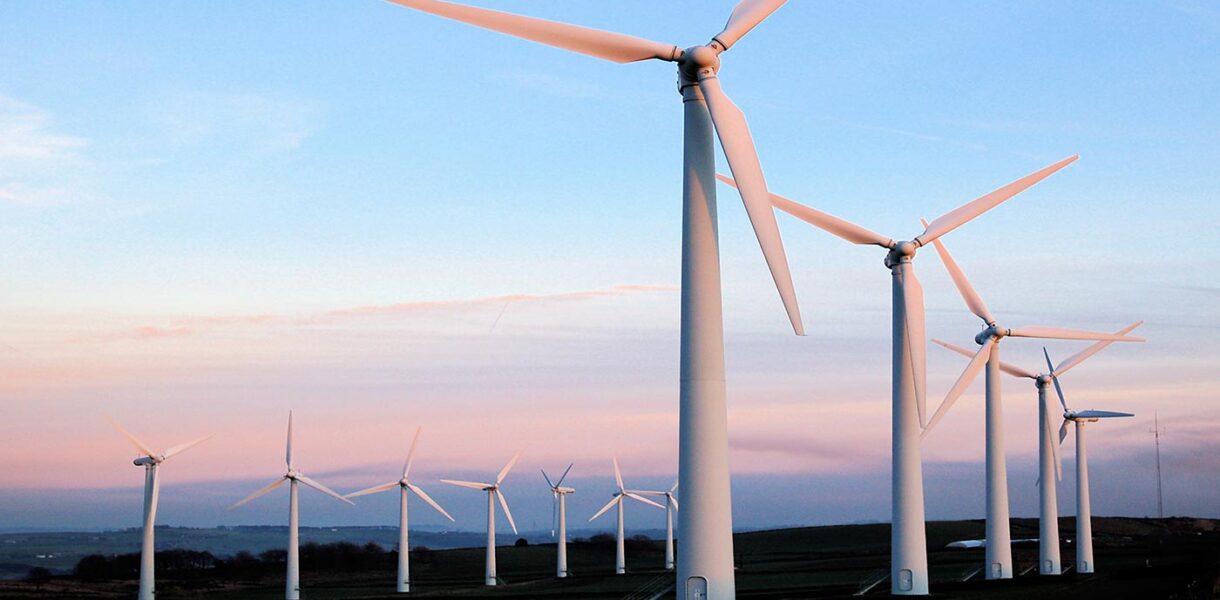
India is a developing country with a population of over 1.35 billion people, nearly 70% of which live in rural areas, and it is expected that India’s energy needs could nearly double by early 2040.[1] In recent years, the topic of an energy shortage has gotten a lot of attention. Many academics and economists believe that energy and growth are inextricably linked. Since the human race has been relying on fossil fuels for our energy needs since the early age of Industrialization, the dwindling dependence on energy from traditional methods such as non-renewable fossil fuels has been predicted for a long time. This reliance on fossil fuels creates a danger that can now be seen, putting the oil market under scrutiny as well as the long-term impact it has had on the environment. The consistent use of fossil fuels has culminated in greenhouse gas emissions into the atmosphere, which is increasing over time. The Paris Climate Accord, which was signed in 2016, is regarded as an instrument to ensure greenhouse gas emission reduction and adaptation to renewable, under which India has promised to source 40 percent of its built power generation capacity from non-fossil fuel sources, also known as renewable, by 2030.[2]
The government of India’s effective initiatives has catapulted India to the frontline and driven it to become one of the world’s most lucrative green energy markets. The government has created regulations, programs, and a flexible climate to encourage international companies to collaborate with domestic players to rapidly revamp the country’s clean energy industry. In the coming years, it is expected that the clean energy market will generate a significant number of domestic jobs.
The scale and growth of a country’s population have a significant impact on energy consumption. With 1.368 billion people, India is the world’s second-most populous country in 2019, with a forecast annual growth rate of 1.18 percent, accounting for nearly 17.74 percent of the world’s population.[3] Every year, India’s population grows faster than any other country on the planet. This factor has a significant effect on India’s energy demand, which is projected to rise at the fastest rate of all major economies by 2040. Coal is one of the energy sources that is serving the bulk of demand, led by renewable energy. After their arrival, renewable options have grown to become the second most symbolic source of domestic power generation, surpassing gas and even oil as a main source of energy by the year 2020. In a country like India, demand for green energy will skyrocket from 17 Mtoe in 2016 to 256 Mtoe in 2040, representing a 12 percent annual rise. Renewable energy demand accounted for around 2% of total consumption in 2016, which is expected to rise to 13% by 2040.[4]
India has paved the way for the rest of the world in the clean energy market, having doubled its potential in the last four years. In the 2017-18 fiscal years, we had 70,000 MW of combined renewable power capacity, up from 35,500 MW in the previous fiscal year.[5] India ranked fourth and sixth in terms of cumulative installed capacity in the wind and solar sectors, respectively, as of December 31, 2018, and seventh in terms of cumulative installed renewable capacity.
FDI in Renewable sector
According to the Renewable Energy Country Attractiveness Index (RECAI), investments in renewable energy in India rose by 22 percent in the first half of 2018 compared to 2017, while investments in China decreased by 15 percent.[6] By the end of 2020, India was supposed to surpass China as the most desirable place to invest in green energy, but by the end of 2019, China had reclaimed the second position, and India had slipped to fourth place in the RECAI. Despite losing two slots, India is aiming to reclaim the lead in the clean energy transition by 2023, with a goal of 175 GW[7]. It has restructured its activities in this sector to accomplish this aim. In 2018, India added more green capacity than normal traditional capacity, as well as hosting the International Solar Alliance (ISA), a first-of-its-kind official summit for 121 countries in 2018. Through this, India is attempting to establish a standard forum for working against aggressive clean energy goals by partnering with countries all over the world. India is also developing several major solar power parks, which are larger than those in China. India is currently constructing half of the world’s ten largest solar parks.
The government’s active involvement, intent, and green energy priorities in the renewable sector have resulted in significant growth that is drawing both foreign and domestic investors. In the coming years, India is expected to draw about USD 80 billion in investments.[8] After careful consideration, India’s government has raised its clean energy capability target from 175 GW to 225 GW by 2022. India receives nearly all of its sunlight during the year and has tremendous hydropower capacity. In the EY clean energy nation attractive index 2018, India was ranked fourth.
The FDI equity inflow in the renewable sector between April 2015 and June 2018 indicates that the 3-month FDI equity inflow in the year 2018-2019 is half that of the whole year 2017-2018.[9] The figure demonstrates that India has a long history of FDI equity inflows. International investors are keen to invest in India, as demonstrated by major FDI investments in the renewable energy market. The renewable sector has benefited from collaboration between Indian governments and various organizations such as the Asian Development Bank and private limited Refresh Power Projects, which are managed by AIRRO Singapore.
Certain policies and guidelines exist to encourage investments, including FDI, in the clean energy market, the recommendations suggested are:
• Reduce FDI restrictions; develop and provide free, clear, favorable, and dependable conditions for international and domestic players, including ease of doing business, access to imports, comparatively competitive labor markets, and protection of intellectual property rights.
• Establish an investment promotion agency (IPA) dedicated to the clean energy market, with a focus on genuine international investors and links to the domestic economy. The government should fund the IPA to provide top-notch facilities as well as immediate access to qualified personnel, technicians, engineers, and managers, which could be needed to attract such investors. After-investment care should also be considered, taking into account the presentation effect of happy investors, the incentive for reinvestment, and the potential for cluster growth due to follow-up acquisitions.
• Over the past decade, the feed-in tariff (FiT) model has become a common global option for generating and raising investment in the renewable energy industry. They are 15-20-year schemes that are carried out by the governments concerned; the government should highlight them to attract investors.
• Policymakers should vigorously endorse policy frameworks such as Power Purchase Agreements (PPA) because they play an important role in establishing a sound foundation that returns and restricts uncertainties for project investors, indirectly encouraging investment availability. Government regulations, in particular, have been relied upon by investors in renewable-energy ventures to ensure that the prices of electricity produced are critical.
Employment in Renewable Sector
According to the IRENA’s 2018 Annual Assessment, global clean energy employment hit about 10.3 million jobs in 2017, a 5.3 percent increase from 2016. Many structural factors support jobs in the sustainable market, but only a few countries are willing to put them into practice. China, Brazil, the United States, India, Germany, and Japan are the leaders in this sector. China leads the solar PV market (65 percent of PV jobs), led by Japan, the United States, India, Bangladesh, Malaysia, Germany, the Philippines, and Turkey.
China has the highest number of green energy employees, with over 3880 million people employed, accounting for 43 percent of all employees worldwide. In India, new solar installations hit a new high of 9.6 GW in 2017, essentially rising the overall installed capacity and increasing solar PV employment by 36% to 164,400 workers, 92,400 of which were on-grid use.
According to IRENA, construction and installation account for about 46% of these workers, while operations and maintenance (O&M) account for 35% and 19%, respectively. India does not manufacture solar PV since it can be imported cheaply from China. Domestic firms (Indian solar project suppliers) had a market share of 7% in 2017-2018, down from 13% in 2014-2015.[10] More people would be able to work in the manufacturing sector if the manufacturing base is developed in India. In 2017, India had the fifth-fastest increase in wind power output in the world, with 4.1 GW, and the fourth largest total capacity in 2018. According to IRENA, the wind industry will employ 60,500 people.
The following are the ongoing scenario about employment in the renewable sector:
(a) The majority of employment in the renewable sector is contract-based, and workers do not have the advantage of permanent positions or security.
(b) Ongoing work in the sector would ensure the industry’s ability to reduce poverty.
(c) Poverty-stricken people face a variety of challenges, including entry-level schooling and access to the labor market due to a lack of knowledge about career opportunities and qualifications.
(d) Few green energy programs take into account the increase in citizen ownership and women’s engagement in the sector.
To ensure an overall growth of the Renewable sector and generation of employment in this sector certain recommendations are as follows:
- When building capacity, the primary emphasis should be on people living in poverty so that they can gain a means of income and be empowered with training in service and maintenance.
- Develop and offer a range of educational opportunities for individuals with the bare minimum of credentials and educate them in green energy. By offering regional training, women will be included in the green workforce.
- Establish a shared bond between training institutes and renewable energy firms to ensure that (a) qualified staff are put in suitable roles before and after the training program, and (b) training programs are customized to the needs of the renewable energy industry, resulting in an effective way of creating jobs while also boosting the renewable energy sector.
- Ensure that people have a sense of ownership in green energy ventures, as this will boost work ethics and lead to the sector’s growth.
- The employee’s data can be gathered for more study, including the work being provided (part-time, full-time, contract-based), the types of requisite qualifications for the job (skilled, semi-skilled, and unskilled), and it will aid in determining the employee’s socio-economic status and making any necessary changes.
Conclusion
The country is supposed to take action to gain private investors’ interest. Inadequate technologies and logistics are hindering the production of renewable energy. This can be addressed by establishing an R&D department dedicated to green energy. More money from the government should be made available to finance this sector’s science and growth projects. There is insufficient qualified staff to teach, demonstrate, and oversee the operation of renewable energy structures, so institutions must be vigilant in their workforce planning.
In its Green Regulatory Framework, the MNRE should make a comprehensive action plan or policy for the promotion of the renewable energy industry. Within a given structure and execution of the policy/action plan, the Action Plan should be established in collaboration with the country’s SERCs. The Must Run Status strategy should be adopted by both the federal and state governments. Allowing for the use of green energies is important. SERCs will be expected to reduce policies and clean energy regulatory confusion. SERCs may be allowed to identify the thrust areas of their renewable energy production.
The government should allocate adequate funds to the renewable energy market. China’s annual allocation for clean energy is 128 times greater than India’s. China’s investment in 2017 was USD 10.9 billion, relative to India’s USD 126.6 billion.[11] The grid budget allocations for wind and solar interactions rose in 2018, but this is insufficient to achieve the sustainable target. The introduction of the Goods and Service Tax (GST) reduced business production in 2017, resulting in a cost increase and posing a threat to the sustainability of existing projects, obstructing Goal achievement.
Since about 90% of solar cells and panels are currently imported from Malaysia, China, and Taiwan to fulfill the requirements,[12] India must build a stable domestic manufacturing process base. Promote the exchange of ideas between companies, universities, and policymakers from around the world to accelerate the implementation of green energy.
Photo Credits: Edfenergy.com
End notes:
India to be biggest driver of global energy demand growth in next two decades: IEA Available at https://www.thehindubusinessline.com/economy/india-to-be-biggest-driver-of-global-energy-demand-growth-in-next-two-decades ↑
https://economictimes.indiatimes.com/industry/energy/power/india-targeting-40-of-power-generation-from-non-fossil-fuel-by-2030-pm. ↑
India Energy Outlook 2021, World Energy Outlook Special Report, February 2021 ↑
Report of the Expert Group on 175 GW RE by 2022, NITI Ayog Available at https://niti.gov.in/sites/default/files/energy/175-GW-Renewable-Energy.pdf ↑
Global trends in renewable energy investment 2018, Bloomberg new energy(2018).Available at http://www.iberglobal.com/files/2018/renewable_trends.pdf ↑
Report of the Expert Group on 175 GW RE by 2022, NITI Ayog Available at https://niti.gov.in/sites/default/files/energy/175-GW-Renewable-Energy.pdf ↑
India to attract investments worth $80 bn in renewable energy: Report by Jayajit Dash available at https://www.business-standard.com/article/economy-policy/india-to-draw-investments-worth-80-bn-in-renewable-energy-sector-report-118111401225_1.html ↑
IBEF Report on Renewable energy in India,2018 available at : https://www.ibef.org/download/Renewable-Energy-Report-August-2018.pdf ↑
Renewable energy and Jobs –Annual review 2018 (2018). Available at https://irena.org//media/Files/IRENA/Agency/Publication/2018/May/IRENA_RE_Jobs_Annual_Review_2018.pdf ↑
Kumar. J, C.R., Majid, M.A. Renewable energy for sustainable development in India: current status, future prospects, challenges, employment, and investment opportunities. Energy Sustain Soc 10, 2 (2020). ↑
Government imposes safeguard duty on solar cells import for 2 years available at https://economictimes.indiatimes.com/news/economy/policy/government-imposes-safeguard-duty-on-solar-cells-import-for-2-years/articleshow/65203361.cms?from=mdr ↑





WOW just what I was searching for. Came here by searching for website
Hi there, I found your blog by means of Google
even as looking for a related matter, your web site got here up, it looks good.
I have bookmarked it in my google bookmarks.
Hello there, just become alert to your weblog through Google,
and found that it’s truly informative. I am going to watch
out for brussels. I will appreciate for those who proceed this in future.
Many folks will probably be benefited out of your writing. Cheers!
Thank you for sharing.
It’s awesome to go to see this web site and reading the views of all friends regarding this piece of writing,
while I am also keen of getting experience.
all the time i used to read smaller articles or reviews
that also clear their motive, and that is also happening with this paragraph which I
am reading now.